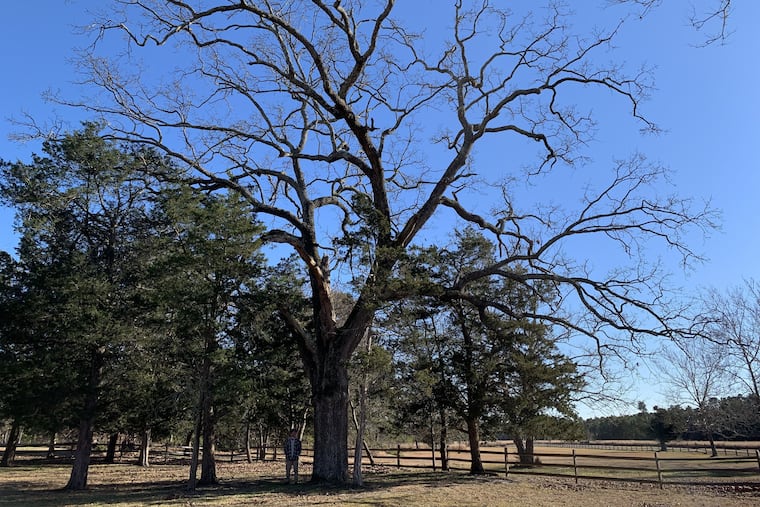Stockton University class stumbles on a ‘champion’ oak of New Jersey
The biggest post oak ever found in New Jersey was discovered not far from an historic mansion built by Philadelphia businessman Joseph Wharton.

Stockton University assistant professor Matt Olson was scouring the neatly kept grounds of Batsto Village in New Jersey’s Pinelands in October for maple trees when he spied what he believed to be a unique tree in the distance.
“I just saw this massive oak, and as I was walking closer to it, I saw that it wasn’t a white oak, Quercus alba, but something a little different,” Olson said. “It turned out it was a post oak. I could not remember seeing one of that size in the area.”
What he spotted ultimately turned out to be the biggest, or “champion,” post oak known in New Jersey. It was found not far from the historic mansion built by Philadelphia businessman Joseph Wharton that so many visitors tour.
“It’s just truly just a massive specimen,” Olson said of the tree.
Olson had been looking for red maple trees with syrup tapping potential for his class in dendrology — the study of trees, woody plants, and shrubs. On Oct. 6, he led the students back to the site to help measure the oak, thinking it might be special.
» READ MORE: The iconic Fairmount Park tree featured in countless Philly skyline photos has been cut down
Post oak, or Quercas stellata, is a species within the white oak family, but tends to be smaller than some other white and red oaks, and has some other subtle differences, such as leaf formation. Post oaks like the deep, sandy soil common to the state’s pine barrens protected as part of the Pinelands National Reserve.
But finding a post oak in such an open area, and one that ultimately measured 64 feet high, with a circumference of 11 feet, 3 inches, came as a surprise. Together, with its 80-foot crown, meaning all the leaves and branches as they extend out, the tree rated 219 points on a standard rating system. The previous New Jersey champion post oak rated 114 points.
The new champion is rooted close to the blacksmith’s shop at Batsto Village in Wharton State Forest. The village was a center for making iron from bog ore that was “mined” from the banks of the streams and rivers. The Iron Works supplied munitions to the Continental Army during the Revolutionary War.
Olson surmises the tree could date to that time. However, he concedes he “doesn’t have a clue” of how old it might be, though the size suggests several hundred years.
After discovering the tree, Olson saw an education opportunity for his students majoring in environmental sciences.
“I decided to take my class out there to measure it to see if in fact it was a new state champion,” he said.
Olson has looked at tens of thousands of trees over his career and never had come upon a potential champion before. So he got to work.
He and his students used a hypsometer, a standard forestry device that uses sound waves and trigonometry to determine tree height. They used a tape measure to determine the crown and circumference.
Olson said the tree appears healthy, despite one broken branch.
Forrest Jennings, 21, one of Olson’s students, said about a dozen or more students ended up measuring the tree, with their professor’s guidance.
“After we had learned about the tree species at Batsto,” Jennings recounted, “Dr. Olson said, ‘We’re going to do something different today: We’re going to try to identify a state champion tree.’ We all walked over and saw the tree was huge.”
As the students took measurements and made calculations, they grew more excited.
“Once we had the number, we realized it was way past the old champion,” said Jennings, who has a dual major in marine biology. “We blew right past it. So we’re like, oh my gosh, this is it. This is the biggest one, and it was really a great moment — super exciting for all of us.”
Jennings, from Lacey Township, Ocean County, said finding a champion tree had extra meaning for him.
“I’m very passionate about trees and all of nature as you can tell from my name,” Jennings said with a laugh. “My parents named me Forrest and my sister Holly. And I grew up exploring the pine barrens of South Jersey.”
The post oak discovered by the Stockton crew will be listed on the New Jersey Department of Environmental Protection’s Big and Heritage Trees of the New Jersey site, complete with an interactive map of all the champion trees.
Before a tree is listed, it has to be nominated as a champion, and then the state has to verify it. That process took a few months.
Joseph Bennett, a New Jersey Department of Environmental Protection assistant regional forester, sent a letter to Stockton acknowledging the designation.
“Trees of this size are mega resources and perform 600 times the environmental benefits of typical trees,” Bennett wrote.
Olson, the professor, isn’t finished in his quest for champion trees.
“I’m going to take my class back out there next year,” he said, “because I’m almost certain there’s another champion out there for another species ... a blackjack oak.”